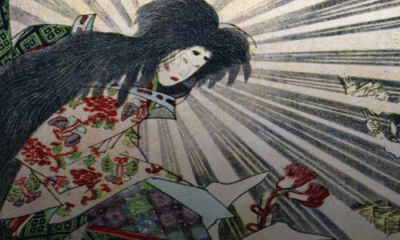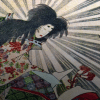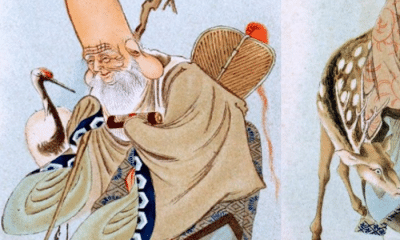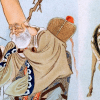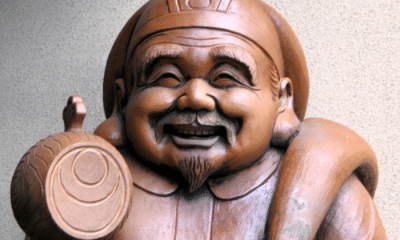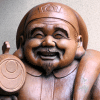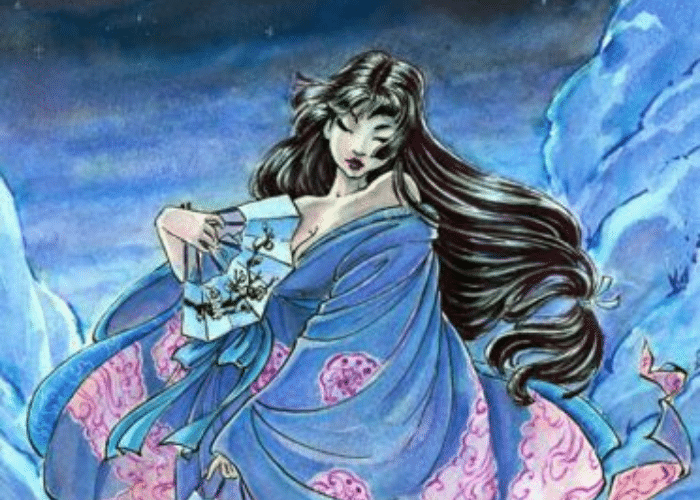
Japanese
Ame-no-Uzume: The Goddess of the Dawn
Ame-no-Uzume: The Goddess of the Dawn
How did a good-natured goddess trick the sun out of hiding? Keep reading to learn about Ame-no-Uzume, the Japanese goddess of the dawn!
In Shinto, the traditional religion of Japan, Ame-no-Uzume was one of the thousands of kami, or spirits, who inhabited both Heaven and Earth. She was a kindly and good-natured spirit who lived in Heaven under the rule of Amaterasu, the sun goddess.
When Amaterasu abandoned her duties, however, even the most powerful kami could not convince her to return. Only a clever ruse by the creative young kami maiden could keep Heaven and Earth from plunging into darkness.
Ame-no-Uzume’s plan won her the role of the goddess of the dawn and saw her credited as the inventor of performance. She came to be associated with some of the hallmarks of Japanese culture.
Her roots, however, may have come from farther outside of Japan than you might think. Similar stories and iconography lead some scholars to believe that Ame-no-Uzume may be more closely related to the dawn goddesses of Europe than those of other East Asian countries.
How Ame-no-Uzume Brought Back the Sun
In the Shinto religion, Heaven and the Earth were filled with kami, or spirits. The most powerful were like gods, while minor kami were mostly nature spirits.
The head of all the kami was Amaterasu, the goddess of the sun. Amaterasu was typically a very noble and dutiful goddess, but in one legend she neglected her duties.
Frightened by her brother, the storm god Susanoo, Amaterasu hid in a cave in Heaven. Without her light, both Heaven and Earth grew cold and dark.
The other kami begged their sun queen to emerge from the cave, but no among of cajoling could convince her to show herself. As she hid in the cave her initial fear became shame and she became more determined to never come out again.
Ame-no-Uzume was a young kami among the eight hundred spirits who throned around the cave’s entrance. She, however, was the one to come up with a clever plan to lure Amaterasu out.
She told the assembled gods to yell and laugh as though a great celebration were happening in Heaven. Their shouts were unconvincing, however, so Ame-no-Uzume gave them something to laugh about.
She pulled over a tub and turned it over to make a temporary stage. She jumped on top of it and began to dance in a silly way.
To get even more of a reaction from the gods, Ame-no-Uzume stripped off some of her clothes. The shouts and laughter from the kami got Amaterasu’s attention.
When the sun goddess called out of the cave to see what was happening, the other gods told her that another, greater kami had appeared. The shouts and laughter were part of the celebrations in honor of this new god’s arrival.
Curious to see this rival god, Amaterasu poked her head out of the cave. Near the entrance, Ame-no-Uzume had hung a mirror and a green jewel used in ceremonies.
When Amaterasu caught a glimpse of her own light in the mirror, she thought it was the new god who had come to take her place. The jewel, she assumed, had been brought out to be used in his coronation.
Among the eight hundred kami, however, the sun queen still could not get a clear look at the god she thought was in the crowd. When she took another step out of the cave, the gods quickly blocked off the entrance so she could not run back in.
Through her cleverness, Ame-no-Uzume had brought the sun back into the world. She became the goddess of the dawn.
Years later, when Amaterasu sent her descendants to rule on Earth, Ame-no-Uzume once again helped her.
Sarutahiko, the leader of the kami on Earth, refused to allow Amaterasu’s grandson to pass over the bridge between Heaven and Earth to take control of the land. Ame-no-Uzume went to convince him, in some stories succeeding through flirtation.
Sarutahiko and Ame-no-Uzume eventually married. Their descendants became the Sarume clan, one of Japan’s noble families.
My Modern Interpretation
Many aspects of Ame-no-Uzume’s myth link her to iconic aspects of Japanese culture.
For example, her dance made her a patroness of theatre and dancing. She is specifically linked to Kagura, a type of ritual dance in Shinto ceremonies, but was said to have invented all performance artforms when she danced for the kami.
While Kagura is typically more formal than the comedic and alluring dance performed by Ame-no-Uzume, it is used to communicate with the gods. Dancers often enter a trance-like state in which they play out the role of a god, sometimes mimicking Ame-no-Uzume herself.
Her ploy also resulted in the creation of two of the three items that have supposedly been passed down by the Imperial Family since its foundation. The green jewel and the mirror that she placed outside the cave are, along with a sword acquired from Susanoo, the Imperial Regalia of Japan.
While these parts of her legend are quintessentially Japanese, some scholars believe that other parts of Ame-no-Uzume’s story have links to cultures from around the world.
It is well-known that many aspects of Japanese culture and mythology were influenced by mainland Asia, specifically China. Less widely-recognized, however, is the impact India had on Japanese history.
Some Japanese kami were influenced not by the traditions of East Asia, but by the Vedic deities of ancient India. The Hindu gods and goddesses were given Japanese names, but parts of their stories remain identifiable.
In the case of Ame-no-Uzume, there are many similarities to the goddess Ushas from the Rig Veda.
Ushas is one of two dawn goddesses in Vedic literature. She is married to Surya, the god of the sun.
In one story, Ushas was imprisoned in a cave by a demonic being. Because she could not clear the path for her husband, the sun could not rise.
Indra used Soma, the sacred food of the gods, to increase his strength and break her out to return light to the world.
Ushas was also said to “make bare [her] bosom” as a sign of her friendliness and goodwill.
Some scholars have directly linked these two depictions of Ushas to the Japanese legend of Ame-no-Uzume.
Although the roles are reversed, Ame-no-Uzume and Ushas are both prominent in stories that involve the sun being shut in a cave. They also expose their breasts in a way that is not usually interpreted as sexual.
Both dawn goddesses are characterized as good-natured, attractive, and youthful.
They also both control or drive away negative spirits. While Ame-no-Uzume charmed Sarutahiko into letting Amaterasu’s grandson pass to take control of the Earth from the wild kami there, Ushas went before her husband and shot at evil spirits to clear a path for his chariot.
If Ame-no-Uzume’s story was inspired by that of Ushas, she has cognates thousands of miles away from Japan. As an early Indo-European goddess, Ushas also inspired goddesses like the Greek Eos, Roman Aurora, Germanic Eostre (Easter), and Slavic Zorya.
In Summary
In Shinto tradition, Ame-no-Uzume is the goddess of the dawn.
She earned that role for her role in forcing Amaterasu, the sun goddess, out of her self-imposed imprisonment. When the sun goddess and queen of Heaven abandoned her duties to hide in a cave, Ame-no-Uzume used a clever ruse to lure her out.
Her plan included convincing Amaterasu that another god had come to claim her place. She danced in front of the other gods so their cheers and laughter would convince Amaterasu that a great celebration was taking place.
Ame-no-Uzume also hung a mirror outside the cave. When Amaterasu peeked out, a glimpse of her own light convinced her that another radiant god was there.
Amaterasu eventually stepped out of the cave, giving the other gods a chance to block its entrance. Ame-no-Uzume had brought back the sun and, in doing so, invented dance and performance.
While Ame-no-Uzume’s artform and artifacts were definitively Japanese, many scholars believe that her origins were not. Similarities in stories and portrays link her to the Vedic goddess Ushas.
An origin from this Indian goddess means that Ame-no-Uzume is closely related to many deities from Europe rather than Asia. The story of Japan’s dawn goddess links the mythologies of Asia’s easternmost culture with those of western Europe, thousands of miles away.


